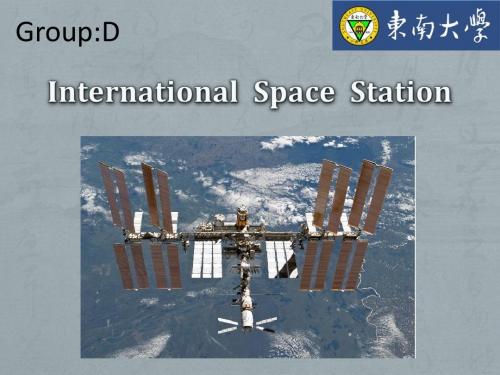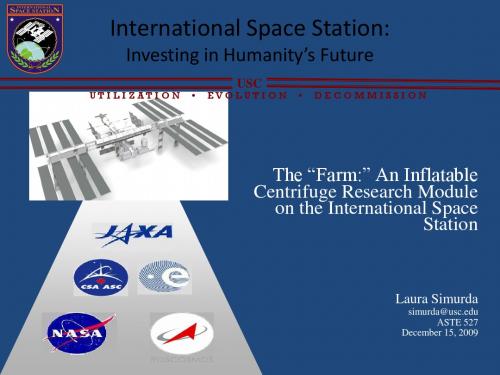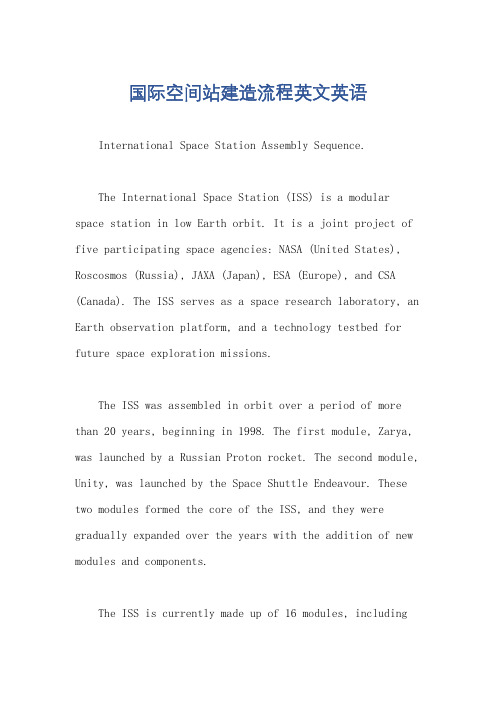国际空间站英语PPT课件
国际空间站英文版

Low gravity and temperatures will give scientists a deeper understanding of superconductivity Future plans are for the researchers aboard the ISS to examine cosmic rays, antimatter, and dark matter
On-Orbit Servicing---- ISS
The I S S
The International Space Station (ISS) is an internationally developed research facility that is being assembled in low Earth orbit. The objective of the ISS, as defined by NASA, is to develop and test technologies for exploration spacecraft systems, develop techniques to maintain crew health and performance on missions beyond low Earth orbit, and gain operational experience that can be applied to exploration missions.
பைடு நூலகம்
Operated as a joint project between the five participant space agencies, the station's sections are controlled by mission control centers on the ground operated by the American National Aeronautics and Space Administration (NASA), the European Space Agency (ESA), the Russian Federal Space Agency (RKA), the Japan Aerospace Exploration Agency (JAXA) and the Canadian Space Agency (CSA).
世界航天史英文简介 ppt课件

Yang Liwei Shenzhou 6(12.October 2005)
Fei Junlong and Nie Haisheng Shenzhou 7 (25.September 2008)
Zai Zhigang ,Liu Boming and Ying Haipeng
firstmoonlandingthirdphaselunarprogram嫦娥3工程automatedmoonlandingreturnsamplefourthphaselunarprogram嫦娥4工程crewedmissionpermanentbases月面驻留19601979russiahassixteenprobes探测器americahaseighteenprobejustsendpictures1996火星全球探勘者号marsglobalsurveyor1997marspathfinder火星拓荒者achievesoftlanding软着陆on20012001火星奥德赛号2001marsodyssey2003火星探测漫游者marsexplorationrover2007凤凰号phoenixtakebackrocks2011yingguang1萤光一号chinaspacestationrussiados礼炮号航天站19711984americaskylab天空实验室1973russiamir和平号空间站19862001esainternationalspacestation国际空间站november1998chinatiangong1天宫1号太空实验舱29september2011spaceshuttle航天飞机enterprise开拓者号航天飞机onlyusecolumbia哥伦比亚号航天飞机4december19811february2003challenger挑战者号航天飞机4april188328january1986discovery发现号航天飞机30august1984atlantis亚特兰蒂斯号航天飞机3october1985challenger7may1992哥伦比亚 eighteen probe
国际空间站

、 An important means for people to understand the positions
of celestial bodies of the universe, distribution, movement, 。 physical state, chemical composition and its evolution. The completion and application of the ISS is a step closer to the construction of factories in space, space power stations, space tourism, the establishment of a permanent residential area (Space Castle).
The Introduction of the ISS
The structure of the ISS is complex and large-scale. It consists of two parts. One part is based on Russian multifunctional cabin, butt joint with Russian service spaces, experiment module, lifesupport capsule ,the US experiment module,JEM,and European Space Agency's Columbus orbital facility, forming the core part of the space station.
The second stage
《Space Exploration》SectionⅠ PPT课件

21
( )7.spacecraft
目( 录 )8.spacewalk
CONTENTS
( )9.jade
( )10.dock
G.n.火箭;火箭弹 H.n.人造卫星;卫星 I.n.交通工具;车辆 J.n.人类
[答案] 1-5 BCGIH 6-10 JFEDA
22
b.给下列短语选择正确的汉语意思
目( 录 )11.be determined to do sth. A.继续做,坚持干
人们聚拢过来,很想知道发生了什么事情。
[自主发现]
be curious to do
很想做某事
14
[巩固内化] 单句语法填空 ①They were very curious _a_b__o_u__t_____ the people who lived upstairs. ②Many men have been attracted by the unknown world and curious _t_o__k_n_o__w____ (know) more about the outer space.
6
1.Finish Ex.2 on Page 38. 2.Finish Ex.3 on Page 38. 3.Finish Ex.4 on Page 39.
7
1.Speaking—Finish Ex.5 on Page 39 by following the example A:You know,I think being an astronaut would be cool. B:Do you want to work in space in the future? A:I’m not sure,but I think it might be too difficult for me.There are so many requirements.First of all,you must be intelligent enough to get a related college degree.Then you have to... B:So what might be the most difficult part for you? A:I guess it might be the...
研究生英语 上课课件Unit 5

2005/5:国际空间站将遭弃置 最后期限迫在眉睫
上世纪90年代初,俄罗斯曾答应帮助伊朗在其境内建设布什尔核电站。 俄、伊在核能领域的合作引起了美国的不安。2000年,美国国会通过的 《防止向伊朗扩散法》规定,在美国确定俄罗斯没有向伊朗出口核武器 和生化武器技术之前,美国将不得购买任何有关俄罗斯的太空技术和其 提供的太空服务。因此,根据这个法律,美方向俄罗斯支付飞船运送费 用的行为属于违法行为。 虽然一些国会议员希望能够有新的协议允许更多的俄罗斯“联盟”号载 人飞船担任空间站的运输任务,但是如果不能够很好地处理好《防止向 伊朗扩散法》对购买俄罗斯太空技术的限制,问题将是“棘手的”。美 国国会科学委员会主席雪伍· 德波特说:“如果我们不能够与俄罗斯达成 一致的话,那么我们在空间站工作的宇航员将不能够支持太久。” 自2003年2月“哥伦比亚”号航天飞机发生空中解体事故后,美国暂时 停止了一切航天飞机的飞行,而代之以使用俄罗斯的载人和货运飞船向 国际空间站运送宇航员和物资。 豁免《防止向伊朗扩散法》,11艘俄罗斯“联盟”号载人飞船帮助美国 向国际空间站运送宇航员。最后一艘“联盟”号将在今年9月份携带一 名美国宇航员飞往空间站,预计于2006年4月返回地球。从此以后,美 国宇航局将必须依靠自己的飞船运送宇航员等。但是即便是美国的航天 飞机恢复正常飞行,美国宇航员也不能在国际空间站作长时间停留,因 为只有俄罗斯的“联盟”号载人飞船被美国宇航局获准可以在国际空间 站进行永久性的对接和救援服务。这样一来,美国科学家和宇航员承担 的有关人类长时间失重状态的课题研究就可能被无限期地拖延下去。
国际空间站:为人类未来投资【英文精品】

Heritage
• NASA’s Centrifuge Accommodation Module (CAM) • 8.9 by 4.4 meters • Two different gravitation levels between 0.1 and 2 g • Cancelled in 2005
– – – – One-quarter Apogee wheat (339 kCal/ 100 g) One quarter lettuce (12 kCal/ 100 g) One quarter cucumber (12 kCal/100 g) One quarter tomato (18 kCal/ 100 g)
What We Can Produce
• Caloric requirements vary by astronaut
– NASA estimates per day:
• Small Woman – 1900 • Large Man – 3200 [1]
• McMurdo Station – 200 square meters and produces up to 140 kg of food each month – 250 heads of lettuce every 10 days • The Farm
Location
• Next to the Japanese Kibo module
Farm Module Layout
• Pressurize to 101.3 kPa or 14.7 psi after docking with the ISS
• Core separated into three segments • Experiments packaged into structures
SATELLITE卫星PPT英文版

Nature satellite
1.Moon(the only one satellite of earth) 2. Titan(the No.16 satellite of Saturn,which is the biggest satellite in solar system
A variety of man-made satellite
FY Series
• • • • Chines own meteorological satellite series. FY-1 :Polar orbiting meteorological satellite FY-2 :Sun-synchronous orbit satellite Observe all Chinese atmosphere and reflect the change immediately.
Chinese Satellite Dong Fang Hong I
• Launched in 1970 • Chinese first man-made satellite • It marks that China became the fifth country which can launch satellites by themselves. • It laid the foundation of Chinese aviation.
The development in different countries
• The first man-made satellite was launched by Russia in 1957. • The US launched Explorer I in 1958. • The French launched A-1 in 1965. • Japan launched Oshumi in efinition 2.Classification 3.Developments
International space stations 国际空间站

Station structure
The ISS is a third generation modular space station. Other examples of modular station projects include the Soviet/Russian Mir, Russian OPSEK, and Chinese space station. Modular stations can allow the mission to be changed over time and new modules can be added or removed from the existing structure, allowing greater flexibility.
Food
Most of the food on board is vacuum sealed in plastic bags. The preserved food is generally not held in high regard by the crew, and when combined with the reduced sense of taste in a microgravity environment, a great deal of effort is made to make the food more palatable. Drinks and soups are sipped from plastic bags with straws, while solid food is eaten with a knife and fork, which are attached to a tray with magnets to prevent them from floating away. Any food that does float away, including crumbs, must be collected to prevent it from clogging up the station's air filters and other equipment.
英语:Module 4 Unit 4《A visit to the Space Museum》课件 上海牛津版(共20张PPT)

A visit to
the Space Museum
in our solar system
Mercury 水星
Venus 金星
Earth
Mars 火星
Jupiter 木星
Saturn 土星
Uranus 天王星
Neptune 海王星
Pluto 冥王星
•Jupiter
780,420,000 km
•Venus
107,500,000 km
•Neptune
4,486,000,000
km
•Saturn
1,431,000,000
km
•Earth
150,000,000
km
•Pluto
5,930,000,000
km
•Uranus
2,877,000,000
km
•Mars
9.Which planet takes the shortest time to spin around the Sun? How long does it take?
Mercury takes the shortest time. It takes 88 Earth days.
oldest
Exercise. thinnest
far farther farthest (from) close closer closest(to) cold colder coldest hot hotter hottest
Which is the …… planet from/to the Sun? Why?
_____ is the …… planet because it is the … from/to ….
人教版高中英语必修三Space ExplorationSectionⅠ课件

him this morning.
2.Yang Liwei was the first _a_s_tr_o_n_a__u_t in China who successfully
栏栏目目导导航航
8 . Whether you are married or single , we all want to feel
_d_e_s_i_re_d_(desire). 9.It is _u_n_i_v_e_r_s_a_ll_y_(universe) acknowledged that the earth goes
栏栏目目导导航航
⑩giant adj.巨大的;伟大的 n.巨人;巨兽;伟人
⑪leap n.跳跃;剧增;剧变(leapt,leapt/leaped,leaped)vi.&vt.
跳过;跃过
⑫mankind n.人类 ⑬agency n.(政府的)专门机构;服务机构;代理处
⑭transmit vt.&vi.传输;发送
around the sun.
10.He __le_a_p_t_/_le_a__p_e_d(leap) on me without a word.
栏栏目目导导航航
1.Over eight years later,on 20 July 1969,American astronaut Neil Armstrong stepped onto the moon,...
精神的;思想的 有智慧的;聪明的;有智力的 宇宙;天地万物 查明;确定;决定
栏栏目目导导航航
国际空间站建造流程英文英语

国际空间站建造流程英文英语International Space Station Assembly Sequence.The International Space Station (ISS) is a modular space station in low Earth orbit. It is a joint project of five participating space agencies: NASA (United States), Roscosmos (Russia), JAXA (Japan), ESA (Europe), and CSA (Canada). The ISS serves as a space research laboratory, an Earth observation platform, and a technology testbed for future space exploration missions.The ISS was assembled in orbit over a period of more than 20 years, beginning in 1998. The first module, Zarya, was launched by a Russian Proton rocket. The second module, Unity, was launched by the Space Shuttle Endeavour. These two modules formed the core of the ISS, and they were gradually expanded over the years with the addition of new modules and components.The ISS is currently made up of 16 modules, includingthe Russian Zvezda service module, the US Destiny laboratory module, the Japanese Kibo laboratory module, the European Columbus laboratory module, and the Canadian Canadarm2 robotic arm. The ISS also has several docking ports, which allow visiting spacecraft to dock with the station.The ISS is a complex and sophisticated spacecraft, and its assembly was a major undertaking. It required the cooperation of multiple space agencies, and it involved the launch of dozens of rockets and space shuttles. The ISS is a testament to the ingenuity and perseverance of the human race, and it is a valuable asset for space research and exploration.Detailed Assembly Sequence.The ISS was assembled in a series of phases, each of which involved the launch of a new module or component. The first phase of assembly began in 1998 with the launch of the Zarya module. The second phase began in 2000 with the launch of the Unity module. The third phase began in 2001with the launch of the Destiny laboratory module. The fourth phase began in 2008 with the launch of the Kibo laboratory module. The fifth phase began in 2010 with the launch of the Columbus laboratory module. The sixth and final phase of assembly began in 2016 with the launch of the Bigelow Expandable Activity Module (BEAM).The ISS is constantly being upgraded and expanded, and new modules and components are being added all the time. The ISS is expected to remain in operation until at least 2030, and it may even be extended beyond that date.Challenges of Assembly.The assembly of the ISS was a complex and challenging undertaking. One of the biggest challenges was the need to coordinate the efforts of multiple space agencies. Each space agency had its own plans and priorities, and it was sometimes difficult to get everyone to agree on a common course of action.Another challenge was the need to assemble the ISS inorbit. This meant that all of the modules and components had to be launched into space and then docked together in orbit. This was a difficult and dangerous operation, and it required a great deal of precision.Despite the challenges, the ISS was successfully assembled and it is now a valuable asset for space research and exploration. The ISS is a testament to the ingenuity and perseverance of the human race, and it is a symbol of international cooperation.。
国际空间站英语PPT

• In September 1993, American VicePresident Al Gore, Jr., and Russian Prime Minister Viktor Chernomyrdin plans for a new space station, which became the International Space Station.
International Space Station
王会羽
The International Space Station (ISS) is a habitable(可居住的), artificial(人造 的) satellite in Earth orbit. The ISS serves as a research laboratory(研究实验 室) that in many fields including biology, physics, astronomy, geography and so on.
此课件下载可自行编辑修改,供参考! 部分内容来源于网络,如有侵权请与我联系删除!
Байду номын сангаас
Station structure
• The ISS is a 'third generation' or modular space station.this allows the mission to be changed over time, new modules can be added or removed from the existing structure, saving considerable costs and allowing greater flexibility.
Lesson 12The spaceship 课件

The spaceship
教学课件
Warm up
寻找
外星人
Searching for Intelligent Alen Life
◆
Have you ever read these books? Do you believe there are aliens or not ?
Oscar jumped at Billy பைடு நூலகம்nd knocked him to the ground.“Oscar!”cried Billy.He was scared and hit Oscar on his head.Then something small fell out of Oscar's ear and Oscar wagged his tail again.
trying
to leand or an
The boy's name was Billy and his dog
was called Oscar.
In the spaceship,the captain was
unhappy.Something was wrong.He
gseonttr
am es eady
Oscar smelled something.Maybe it was good to eat.He picked up a metal object with his teeth.
The captain saw a huge monster:He jumped onto its leg.He climbed upand went into the monsters head."Now I can control you,"he said.
《宇宙之旅》PPT课件 (共31张PPT)

宇宙(Universe)是由空间、时间、物质
和能量,所构成的统一体。是一切空间和 时间的综合。一般理解的宇宙指我们所存 在的一个时空连续系统,包括其间的所有 物质、能量和事件。宇宙根据大爆炸宇宙 模型推算,宇宙年龄大约200亿年。
宇宙全景图
太
阳Байду номын сангаас
自然颜色下的土星
银河系
浩渺的太空,充满了无 穷的奥秘。无限的宇宙,等待 我们去探索,让我们乘上想象 的飞船,加入太空之旅,祖国 未来的神舟11号· 12号· 13 号· · · · · · 将有我们的身影。
国际空间站
国际空间站(International Space Station,
ISS)是一项由六个太空机构联合推进的国际 合作计划,也指运行于距离地面 360 公里的 地球轨道上的该计划发射的航空器。国际空 间站的设想是 1983年由美国总统里根首先提 出的,经过近十余年的探索和多次重新设计, 直到苏联解体、俄罗斯加盟,国际空间站才 于1993年完成设计,开始实施。
挫折的名言 1、 我觉得坦途在前,人又何必因为一点小障碍而不走路呢?——鲁迅 2、 “不耻最后”。即使慢,弛而不息,纵会落后,纵会失败,但一定可以达到他所向的目标。——鲁迅 3、 故天将降大任于是人也,必先苦其心志,劳其筋骨,饿其体肤,空乏其身,行拂乱其所为,所以动心忍性,曾益其所不能。 战胜挫折的名言 1、卓越的人一大优点是:在不利与艰难的遭遇里百折不饶。——贝多芬 2、每一种挫折或不利的突变,是带着同样或较大的有利的种子。——爱默生 3、我以为挫折、磨难是锻炼意志、增强能力的好机会。——邹韬奋 4、斗争是掌握本领的学校,挫折是通向真理的桥梁。——歌德 激励自己的座右铭 1、 请记得,好朋友的定义是:你混的好,她打心眼里为你开心;你混的不好,她由衷的为你着急。 2、 要有梦想,即使遥远。 3、 努力爱一个人。付出,不一定会有收获;不付出,却一定不会有收获,不要奢望出现奇迹。 4、 承诺是一件美好的事情,但美好的东西往往不会变为现实。 工作座右铭 1、 不积跬步,无以至千里;不积小流,无以成江海。——《荀子劝学》 2、 反省不是去后悔,是为前进铺路。 3、 哭着流泪是怯懦的宣泄,笑着流泪是勇敢的宣言。 4、 路漫漫其修远兮,吾将上下而求索。——屈原《离骚》 5、 每一个成功者都有一个开始。勇于开始,才能找到成功的路。 国学经典名句 1、知我者,谓我心忧,不知我者,谓我何求。(诗经王风黍离) 2、人而无仪,不死何为。 (诗经风相鼠) 3、言者无罪,闻者足戒。 (诗经大序) 4、他山之石,可以攻玉。 (诗经小雅鹤鸣) 5、投我以桃,报之以李。 (诗经大雅抑) 6、天作孽,犹可违,自作孽,不可活。(尚书) 7、满招损,谦受益。 (尚书大禹谟) 青春座右铭 1、爱的力量大到可以使人忘记一切,却又小到连一粒嫉妒的沙石也不能容纳。 2、把手握紧,什么也没有;把手伸开,你就拥有了一切。 3、不在打击面前退缩,不在困难面前屈服,不在挫折面前低头,不在失败面前却步。勇敢前进! 4、当你能飞的时候就不要放弃飞。 5、当你能梦的时候就不要放弃梦。 激励向上人生格言 1、实现自己既定的目标,必须能耐得住寂寞单干。 2、世界会向那些有目标和远见的人让路。 3、为了不让生活留下遗憾和后悔,我们应该尽可能抓住一切改变生活的机会。 4、无论你觉得自己多么的不幸,永远有人比你更加不幸。 5、无论你觉得自己多么的了不起,也永远有人比你更强。 6、打击与挫败是成功的踏脚石,而不是绊脚石。 激励自己的名言 1、忍别人所不能忍的痛,吃别人所别人所不能吃的苦,是为了收获得不到的收获。 2、销售是从被别人拒绝开始的。 3、好咖啡要和朋友一起品尝,好机会也要和朋友一起分享。 4、生命之灯因热情而点燃,生命之舟因拼搏而前行。 5、拥有梦想只是一种智力,实现梦想才是一种能力。 6、有识有胆,有胆有识,知识与胆量是互相促进的。 7、体育锻炼可以(有时可以迅速)使人乐观(科学实验证明)。 8、勤奋,机会,乐观是成功的三要素。(注意:传统观念认为勤奋和机会是成功的要素,但是经过统计学和成功人士的分析得出,乐观是成功的第三要素) 9、自信是人格的核心。 10、获得的成功越大,就越令人高兴。
Unit 4 Space Exploration Listening and Talking 课件

A: I wonder how they get exercises on space--it's not like they can go out jogging.
C: I'd never thought of that. But then, after they exercise, I'm very keen to find out how they wash their clothes.
Work in pairs and guess whether thห้องสมุดไป่ตู้y would be useful for astronaut in space.
soap
towel
guitar
shower
mircowave
pen
tape
tissue
The most useful items by far in space would appear to be the tape and the tissues. Both are light and do not take up much space, and neither of them can cause a mess which is difficult to clean up.
for us. We just have to _________________and enjoy it. 3. fIlokantoawwaasytronauts cannot shower in space sikneceeptyhoeuwrsaetlevrews oclueladn __________a_s_o_a,psoy Ito’dwleolve to know how you ____________________. 4th. eWseamusee_w_a_y_a_s_________to wash. And we brush our teeth _sw__a_ll_o_w_________we do on Earth. But astronauts usually
人教版Unit4SpaceExplorationLanguagepoints(共23张PPT)

他熟悉出口手续。
2) Police insist that Michael did not follow the correct procedure in applying for a visa.
警方坚持认为迈克尔没有按正确的程序申请签 证。
2. 警察已经开始对此事件进行调查。 The police have launched an investigation into the incident.
3. 公司的花费也随着一份新星期日杂志的 推出而增加。
7. These disasters made everyone sad and disappointed, but the desire to explore the universe never died.
1) She believed that she could make an excellent women astronaut.
她坚信自己会成为一名出色的女宇航员。
2) John's desire to be an astronaut is clear to us.
我们都清楚约翰有一个当宇航员的强烈愿望。
1) They were deeply disappointed at the result of the game.
他们对比赛结果深感失望。
2) I am so disappointed with myself.
我对自己感到非常失望。
3) I am disappointed that you didn't call me yesterday.
Language points
- 1、下载文档前请自行甄别文档内容的完整性,平台不提供额外的编辑、内容补充、找答案等附加服务。
- 2、"仅部分预览"的文档,不可在线预览部分如存在完整性等问题,可反馈申请退款(可完整预览的文档不适用该条件!)。
- 3、如文档侵犯您的权益,请联系客服反馈,我们会尽快为您处理(人工客服工作时间:9:00-18:30)。
Research on the ISS improves knowledge about the effects of long-term space exposure on the human body. Subjects currently under study include muscle atrophy, bone loss, and fluid shift.
5
Station structure
• The ISS is a 'third generation' or modular space station.this allows the mission to be changed over time, new modules can be added or removed from the existing structure, saving considerable costs and allowing greater flexibility.
10
Work
• In general, the crew works ten hours per day on a weekday, and five hours on Saturdays, with the rest of the time their own for relaxation or work catch-up
• Astronaut Ron Garan during an STS-124 ISS assembly spacewalk
6
Station systems and operations
• Life support • Power supply • Docking • Work
7
Life support
8
Power supply
Double-sided solar, or Photovoltaic arrays, provide electrical power for the ISS. These bifacial cells are more efficient and operate at a lower temperature than singlesided cells commonly used on Earth, by collecting sunlight on one side and light reflected off the Earth on the other.
11
Crew health
• The most significant adverse effects of longterm weightlessness are muscle atrophy and deterioration of the skeleton, or spaceflight osteopenia.So...
International Space Station
1
The International Space Station (ISS) is a habitable, artificial satellite in low Earth orbit. The ISS serves as a research laboratory that has a microgravity environment in which crews conduct experiments in many fields including biology, human biology, physics, astronomy and meteorology.
3
Origins
• The International Space Station represents a combination of three national space station projects, NASA's Freedom, the RSA's Mir-2, and the European Columbus space stations.
12
Platform
life science
The station provides a unique environment for the testing of the spacecraft systems that will be required for missions to the Moon and Mars.
2
The station is maintained at an orbit between 278 km (173 mi) and 460 km (286 mi) altitude, and travels at an average speed of 27,743 km/h (17,239.2 mph), completing 15.7 orbits per day. The ISS is operated by Expedition crews of six astronauts and cosmonauts .
9
Байду номын сангаас
Docking
• Spacecraft from Russia and Europe are able to launch and fly themselves without human intervention
• From 26 February 2011 to 7 March 2011, during STS-133, four of the governmental partners (United States, ESA, Japan and Russia) had their spacecraft (NASA Shuttle, ATV, HTV, Progress and Soyuz) docked at the ISS
4
• In September 1993, American Vice-President Al Gore, Jr., and Russian Prime Minister Viktor Chernomyrdin announced plans for a new space station, which eventually became the International Space Station.
